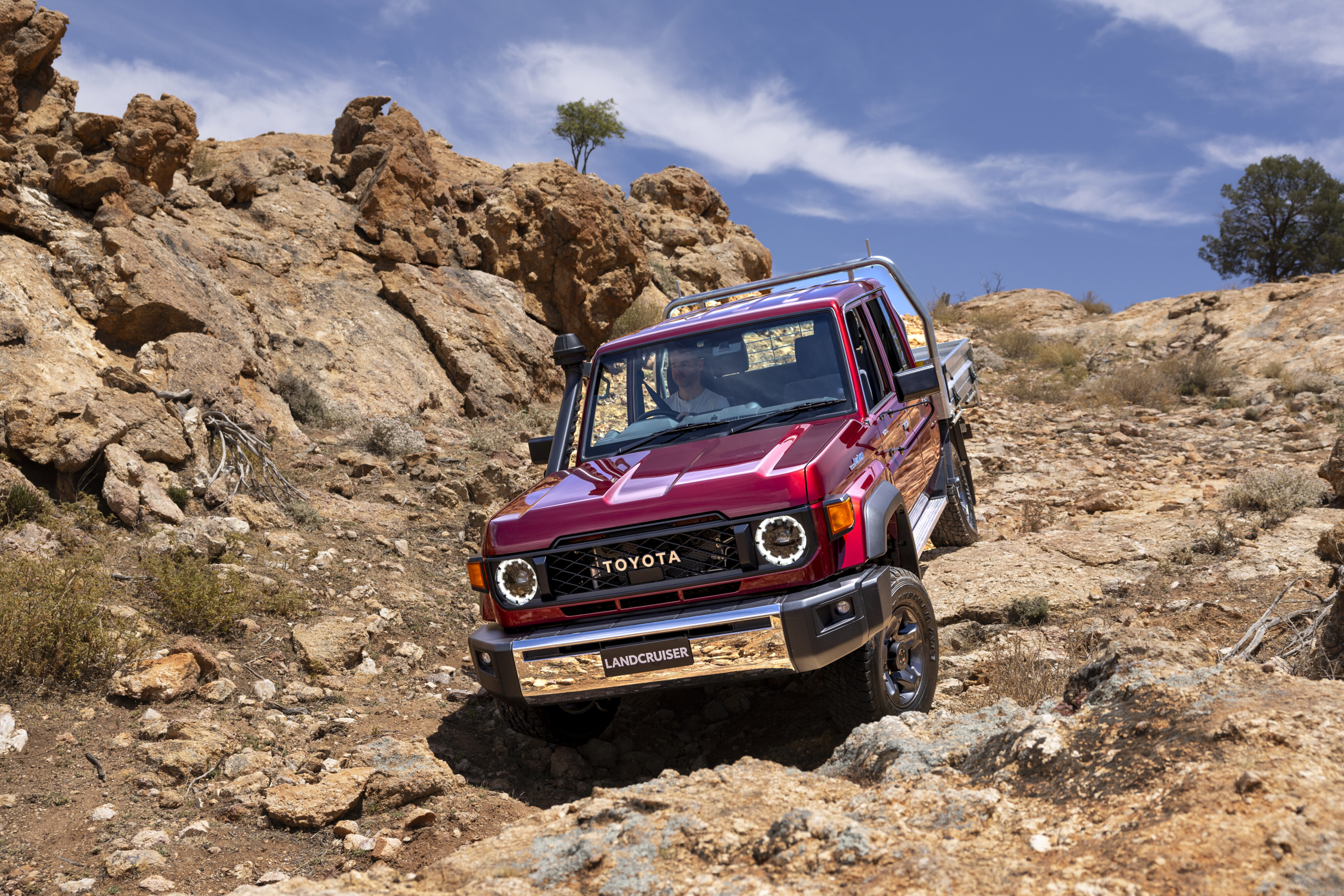
Things we like
- Rugged go-anywhere capability
- Ease of use with the automatic
- Range of models and body styles
Not so much
- Delays of V8 production and availability
- No manual with four-cylinder
- No automatic with V8
It’s been the topic of so much negative chatter ever since Toyota announced that it would be fitting a four-cylinder engine in its legendary 70 Series range of LandCruisers, but now that the covers are off and we’ve driven the facelifted LC70, we have to say that any negativity was unwarranted.
Yep, the four-cylinder engine and six-speed automatic transmission 70s do everything that the V8 models do… and they do most things better!
For those who still want a V8 engine and manual gearbox, Toyota still offers that combination across the range, but the order books for them remain closed while they company tries to fulfil a 12-month backlog of V8 70 orders. In the meantime, Toyota will happily sell you a four-cylinder model and, reading between the lines, the days of the V8 are numbered.
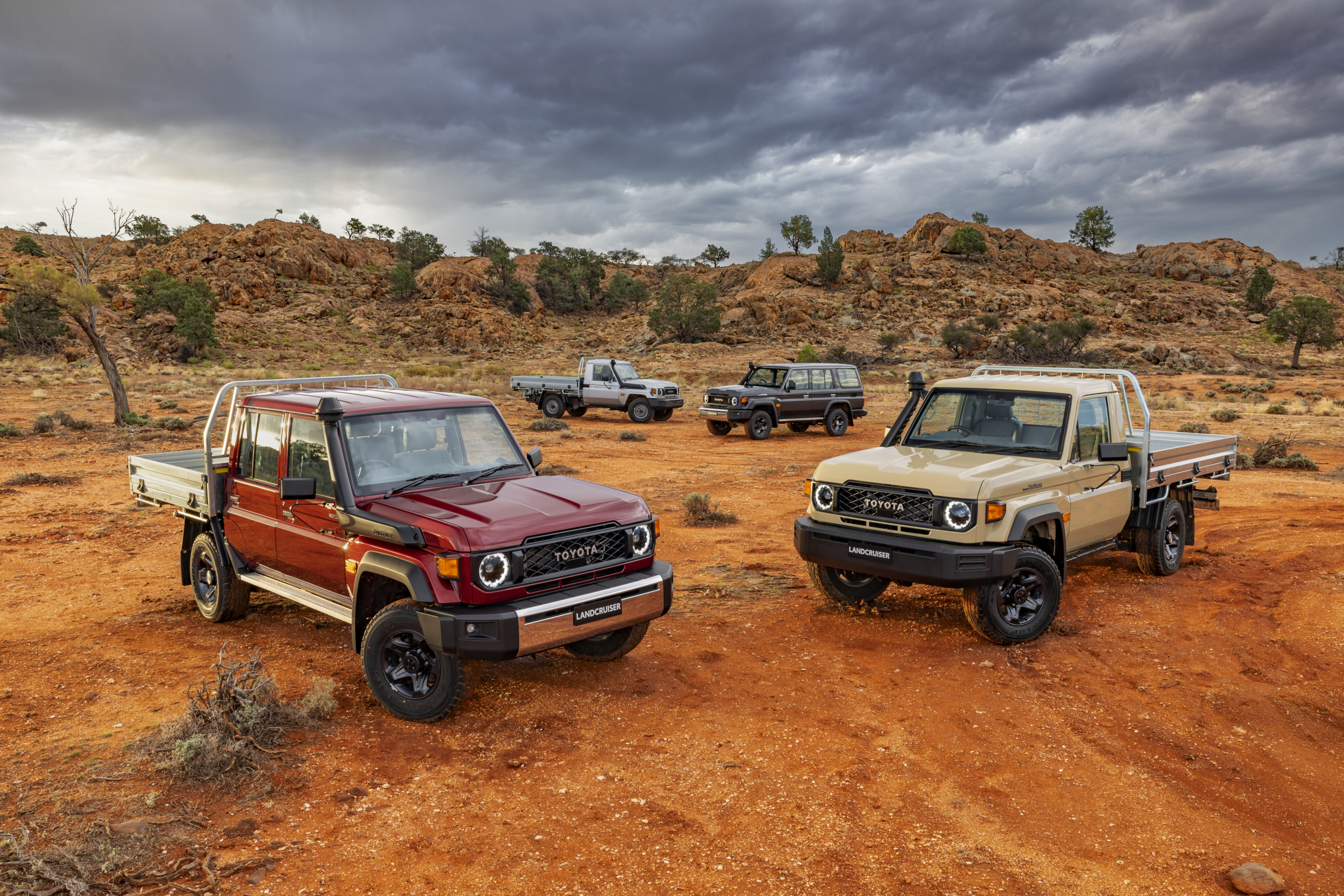
Let’s start with the range on offer. As it encroaches on four decades of production, the LandCruiser 70 will remain available in four body styles; LC78 TroopCarrier, LC76 four-door wagon and LC79 single and double cab tray backs.
All models are being offered with the choice of V8 and I4 engine options, except for the base LC76 Workmate which will be four-clinder/auto only. That is the cheapest vehicle in the range of workhorses and starts it at $75,600, while the LC79 double-cab GXL V8 tops the line-up at $87,600. The V8/manual combination attracts a $4100 premium over the I4/auto. Optional extras include front and rear differential locks for $1500, and premium paint costs $675.
| Model | 1GD 2.8-litre auto | 1VD 4.5-litre man |
|---|---|---|
| 76 Series WorkMate Wagon | $75,600 | |
| 76 Series GXL Wagon | $79,800 | $83,900 |
| 78 Series Troop Carrier WorkMate | $79,200 | $83,300 |
| 78 Series Troop Carrier GXL | $82,500 | $86,600 |
| 79 Series Single Cab Chassis WorkMate | $76,800 | $80,900 |
| 79 Series Single Cab Chassis GX* | $78,800 | $82,900 |
| 79 Series Single Cab Chassis GXL | $80,900 | $85,000 |
| 79 Series Double Cab Chassis WorkMate* | $79,300 | $83,400 |
| 79 Series Double Cab Chassis GXL | $83,500 | $87,600 |
JUMP AHEAD
- What powertrains are available
- Drive impressions
- Off the road
- What's in the box?
- What's new?
- Who's going to buy it?
- VERDICT
- Specs
What powertrains are available?
The big news is the inclusion of the 1GD 2.8-litre four-cylinder engine across the model range.
This is the same engine that is found in the HiLux, Prado and Fortuner, and it makes the same 150kW and 500Nm as it does in those models. Yes, that is more torque than the 1VD 4.5L V8 makes in standard trim (151kW/430NM) and no, the LandCruiser doesn’t get the 165kw/550Nm variant that you find in the Hilux GR Sport, nor the 48-volt assisted version that will appear in those other models later in 2024.
With its wide usage across the Toyota business the 1GD is a well proven and generally reliable workhorse. Sure, it’s had its DPF issues in the past which are unrelated to the engine itself, and Toyota assures us that those problems are behind it now.
Toyota is quoting a combined-cycle fuel-consumption figure of 9.6L/100km from the 1GD 70s, compared to 10.7L/100km for the 1VD engine, and while we are yet to do our own fuel usage testing on these vehicles, we’re sure thee numbers will be nowhere near the claimed ones in real-world driving scenarios.

The Aisin six-speed auto matches beautifully with the torquey 1GD engine and is the key to making this combination the easiest to drive in the LC70 range. The gear shifter is well positioned in the new console and has a separate gate for fore and aft manual gear selection.
Meanwhile, the 1VD-FTE engine, five-speed manual combination remains unchanged. It’s gruff and grunty and gets on with the job, in all conditions. It’s characterised by its lazy nature that seems to never raise a sweat when climbing mountains or hauling loads, all performed with that sweet V8 diesel engine grumble. And there are plenty of options available to tune more performance out of the V8, and make it sound even better!
Because of the nature of the V8 engine, you can almost drive the manual like an automatic; it will happily lope along in any gear, especially when off road in low range. The only complaint with this ’box is that it could do with a sixth ratio, which would make it better suited to highway touring by dropping the revs.
As it stands, the I4/auto revs around 600rpm slower than the 1VD/manual at 100km/h in top gear, making it a more pleasant drive and more economical on the highway.
Drive impressions
Not only is it better on the open road, but the I4/auto combo is easier and more pleasant to drive around town, when towing and even off road. Other than the soundtrack, it does everything better than the V8.
The four-cylinder engine feels lively compared to the V8. It’s more willing to get up and go, while the V8 likes to lope along and take its time to build speed when you put your foot down. The auto transmission not only has an extra ratio that benefits acceleration, but the final drive is a lower at 4.3:1 compared to the V8 model’s 3.09:1.
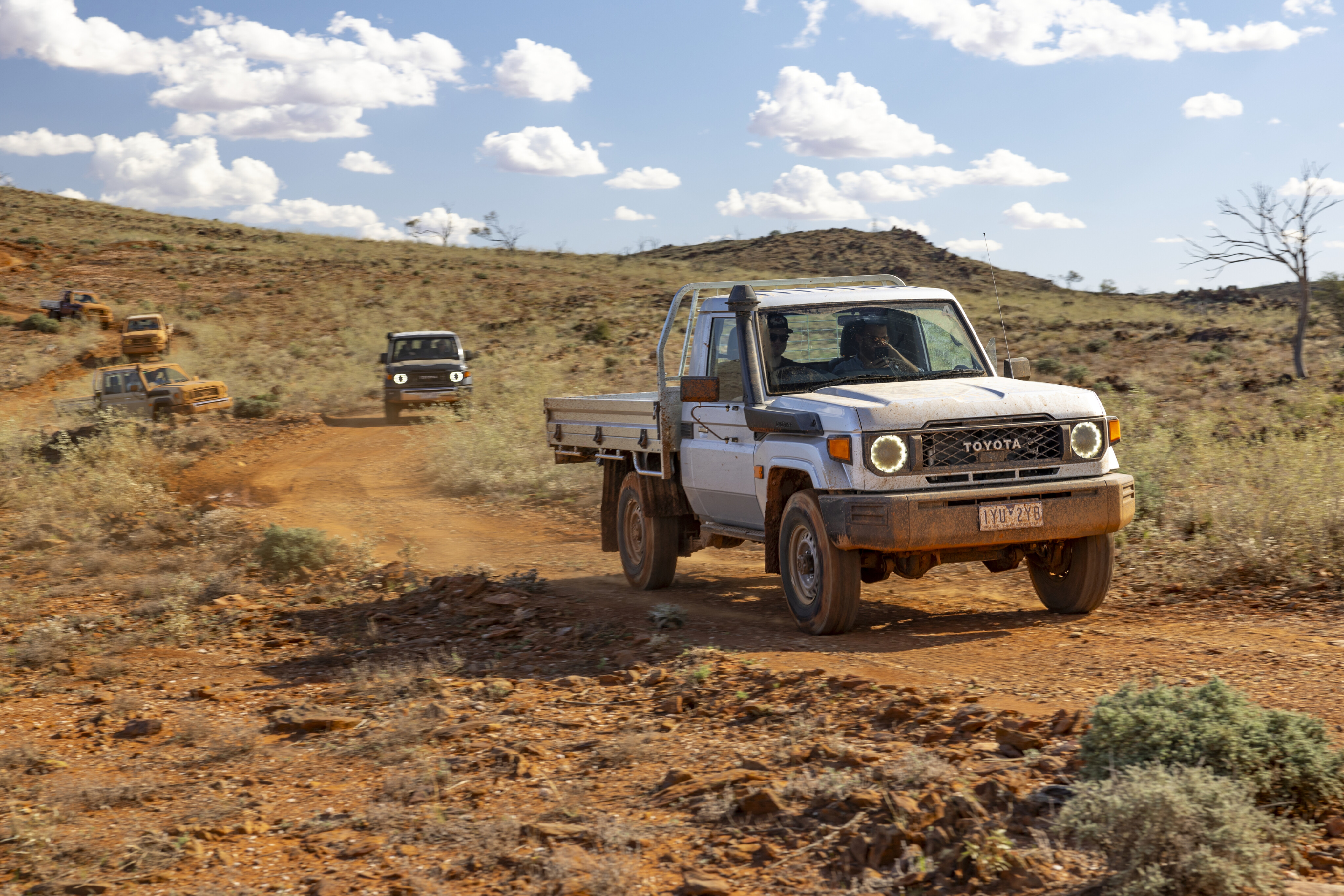
Nowhere is this performance difference more evident than when towing with the two powertrains. Toyota had a pair of LC79s available to tow a Kedron off-road caravan it claimed tipped the scales at 3100kg. The drive loop included gravel and some sealed roads, and the four-cylinder/auto was far more spritely in its pick up when towing the van, while manually shifting the auto was easy when it came time to brush off speed for descents or when approaching washouts.
By comparison the V8 picked up speed more lazily when rowing through the gears but it cruised just as nicely once up to speed. But it was significantly slower than the four-cylinder vehicle when accelerating out of washouts – we first tried third gear but acceleration was lacking compared to the four-cylinder vehicle, and while using second gear created more noise from the engine, there was very little if any improvement in performance.
For many years we’ve heard buyers asking for an auto transmission for towing with a 70 Series and we have seen aftermarket auto conversions costing north of $20,000. Toyota has answered this call with the six-speed automatic transmission and potential buyers needn’t been concerned about the performance of the four-cylinder engine.
Off the road
The off-road section of the launch covered a technical rock course, deep moguls and general bush tracks, and the four-cylinder 70s made light work of these obstacles, as did the V8s, but crossing all terrains was easier in the four-pot.
The throttle application is much smoother and less jerky than that in the V8, even if they both do the same job better than almost any other production 4x4 vehicle. A steep off-road rock loop that defied belief for a heavy production vehicle was experienced alongside a Toyota test driver and it truly impressed. It was done in a LC76, and he left the lockers disengaged, letting the ETC do all the work, and it barely slipped a tyre.

The four-cylinder Cruisers also get Downhill Assist Control (DAC) and the test driver showed how easily this system controls wheel speed and slip on the steep rock face. Unfortunately the DAC in the 70s only has a single speed setting, unlike the adjustable systems in other off-road vehicles. While DAC is not available in the V8, low-range first gear is all that’s needed thanks to decent reduction and impressive engine braking.
Both powertrains now have a hill-start assist feature that holds the brake for a few seconds when you let it off on steep hills. It’s really only a benefit in the manual and even there, it was never really a problem without it.
The LandCruiser’s coil front and leaf rear suspension is relatively stiff by modern standards in line with the vehicle’s working-truck design. It still articulates well over uneven terrain, and the ETC does excellent work. The Kedron van used on the towing loop was said to be putting around 290kg on the tow ball and again, the suspension was unfussed by this extra weight on the back of both the I4 and V8 Cruisers.
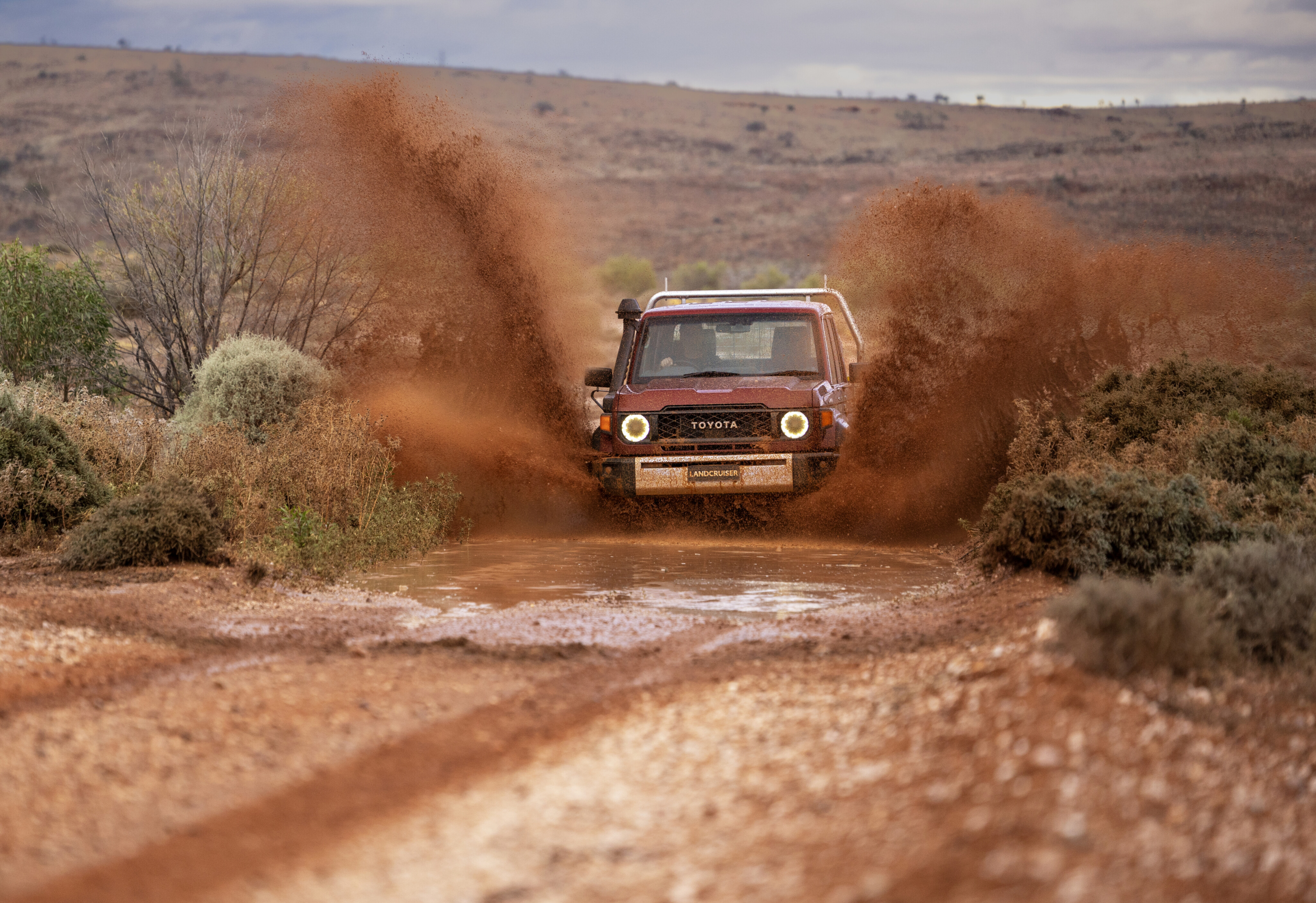
On open gravel roads the Cruiser treats ruts with disdain and soaks up bumps with no regard. The 70 Series is one of those vehicles that really starts to make sense once you get it out of town and off the blacktop, where it feels more at ease and able to take on the conditions better than most other vehicles.
That upright 40-year old cabin offers plenty of headroom and great vision from its glasshouse, but on the highway it generates a hurricane of wind noise around the A- pillars that plays in concert with sucking sounds from the standard air intake snorkel.
What's in the box?
In a world of new vehicles that are being overloaded with features and technology the LandCruiser 70 stays true to its working-truck heritage and offers the bare minimum.
The Workmate models have wind-up windows and vinyl-covered floors. Stepping up to the GXL gets you carpets and power windows, but you lose the handy little quarter vent windows that feature on the base models. Air conditioning is standard and the HVAC controls look to be carried over from the original 1984 models – whether they were kept for functionality or nostalgia, it’s nice to see them still there.
What's new?
Aside from the 1GD/auto powertrain and new tech under the skin, the only other changes to the LC70 are cosmetic.
Toyota has doubled-down on the retro look with the revised front-end reverting back to round headlamps, albeit with LED DRLs, a taller bonnet over a revised grille and lower venting that replicates the earliest 70s. There’s even an upper vent atop the grille that is very 40 Series like. The taller bonnet conceals large vents to feed the top-mounted engine intercooler on the V8 models while on the I4 engine, the air-to air intercooler used on Hilux and Prado has been replaced with a water to air cooler/heater for improved cold-start emissions.
Inside there is a new gauge binnacle that also has a retro 40 Series vibe about it, but includes a 4.2-inch information display which has a digital speedometer, a new 6.7-inch infotainment screen with wired Apple Carplay and Android Auto, and a new steering wheel with more control buttons than before. Air conditioning and cruise control are standard while front and rear differential locks come standard on GXL models, but are optional on lower grades.
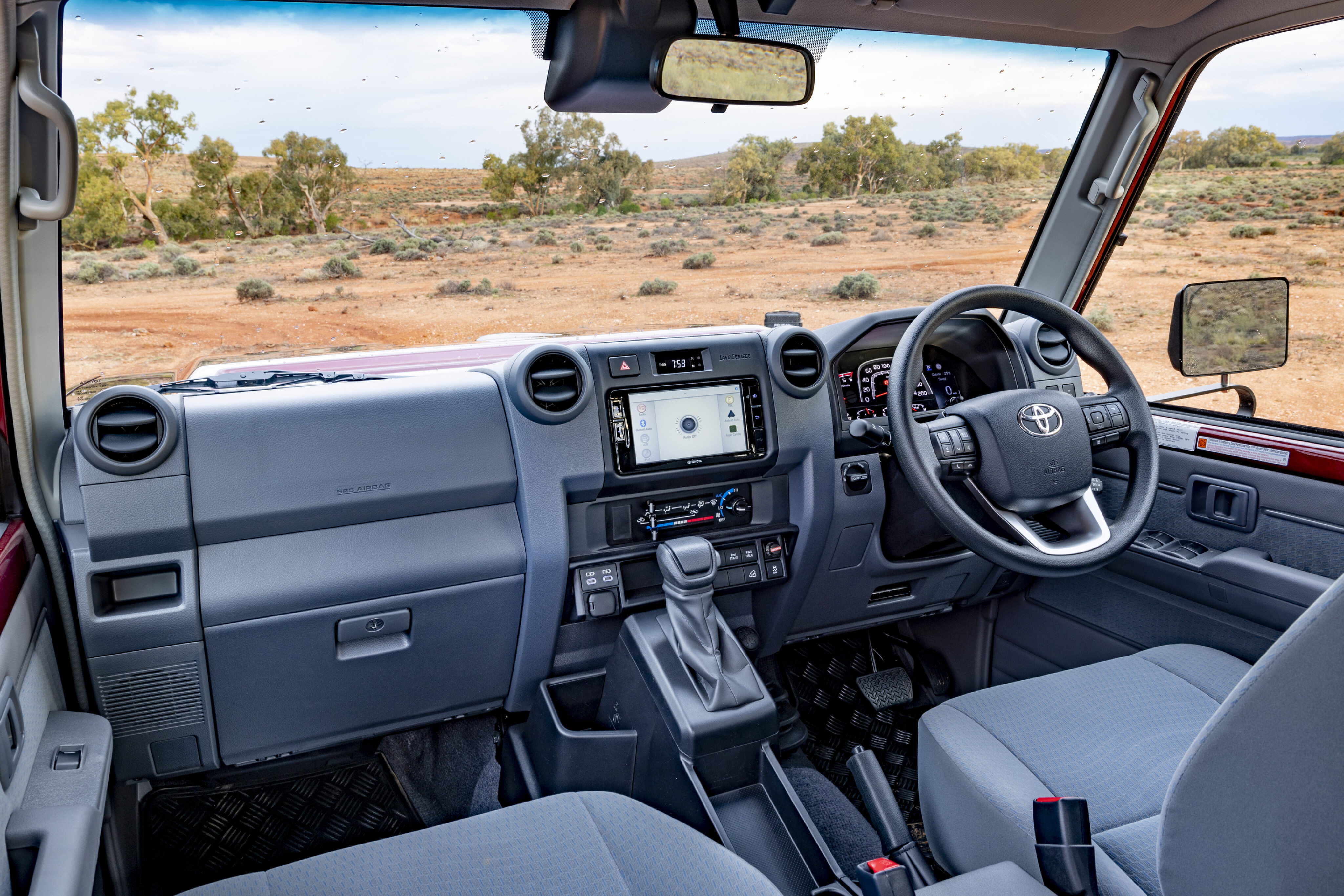
Safety-wise, Toyota’s Safety Sense system includes pre-collision with day and night pedestrian and daytime cyclist detection, lane departure alert with steering assist that only works on the brakes and not directly on the Cruiser’s hydraulic power steering, speed-sign recognition, auto high-beam, ABS, electronic stability and traction control, driver and front passenger airbags but none for back seat passengers, downhill assist control on auto models only, and only the four-cylinder auto wagon gets a reversing camera.
The LandCruiser 70 Series remains a very agricultural vehicle and its 40-year old architecture means that integrating the latest safety systems is a huge challenge for the engineers, hence the lack of the latest safety kit you can find on newer vehicles.

One thing that hasn’t changed on the new Cruisers is the disparity between front and rear wheel tracks. Ever since Toyota fitted the V8 engine to the 70 Series and had to widen the front-end, the front wheel track has been 95mm wider than the rear. This is seen by many to be a problem, as the rear tyres are not following in the tracks of the front tyres over soft and rutted terrain, causing stability problems. Some LC70 owners spend thousands of dollars on a new rear axle housing to rectify this.
Theoretically, with the inline four-cylinder engine in the front of the LC70, the wider axle is not actually needed and Toyota could refit the earlier model unit from the HDJ 70s. But the company doesn’t see the wheel-track disparity as a problem and has not sought to change it.
When asked about it, a Toyota Australia spokesperson said that widening the rear axle to match the front would not be an easy job as it would require body modifications to fit it under the 76 Wagon and 78 TroopCarrier.
Who's going to buy it?
The 70 Series LandCruiser has always been the vehicle of choice for adventurous overlanders, off-road tourers, NGOs, fleets where off-road use is required, and anyone looking for a tough and dependable vehicle that can take them wherever they want to explore.
Enthusiasts love the customisation possibilities of the 70 platform for fitting bigger off-road tyres, better suspension, a custom touring canopy or fitting out a TroopCarrier as a home-on-the-road. The 70 is one of the most modified and customised 4x4s on the market, and with this update that will remain the case.
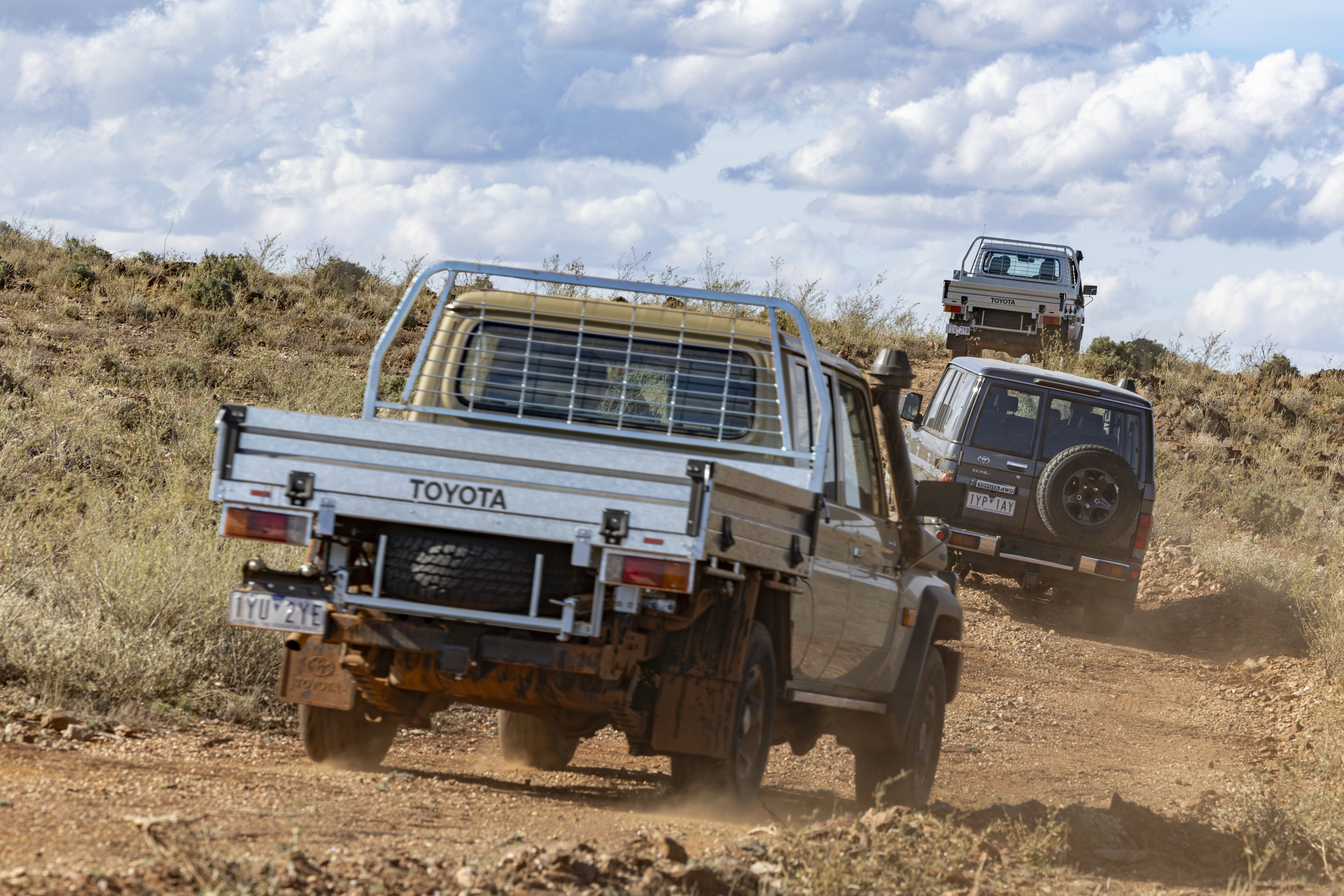
The inclusion of an automatic transmission will entice those who want to tow but convincing them that the four-cylinder engine is up to the job might be a hard task, while the auto will also appeal to fleet owners who need all-road ability but can’t trust their employees with a manual gearbox. The four-cylinder option also opens up the 70 to buyers not allowed to own or drive a V8-powered vehicle.
The four-cylinder will be a hard-sell to enthusiasts who don’t trust the smaller-capacity engine in a large heavy-duty 4x4, and they will continue to queue up to order a V8 model… if and when they eventually can. Any uncertainty as to the future of the V8 engine option will only promote the desire for that driveline further, and there’s no doubt they will remain in demand.
Verdict
The four-cylinder automatic LandCruiser does everything the V8 manual does, only better.
While many won’t believe that, or will refuse to believe it, our couple of days driving the various 70 Series models and drivetrains back-to-back certainly revealed it to be true.

Not only does the automatic transmission make the 70 easier to drive, but the 1GD engine is more enthusiastic than the V8, and with less weight over the front-end it feels a touch more nimble in the handling department. Plus that lighter weight also adds around 55kg to the vehicle’s payload capacity.
The four-cylinder engine also goes some way to future proofing the 70 Series against Euro 6 and higher emission regulations that the V8 won’t be able to meet, and anything that keeps this legendary 4x4 on the tracks is a good thing in our book.
Specs
| 2024 LandCruiser 79 GXL double-cab | ||
|---|---|---|
| Price | $83,500 | $87,600 |
| Engine | I4 turbo-diesel | V8 turbo-diesel |
| Capacity | 2755cc | 4461cc |
| Max power | 150kW@3000-3400rpm | 151kW@3400rpm |
| Max torque | 500Nm@1600-2800rpm | 430Nm @1200-3200rpm |
| Transmission | 6-speed automatic | 5-speed manual |
| 4x4 system | Part-time, dual range | Part-time, dual range |
| Crawl ratio | 38.51:1 | 44.05:1 |
| Construction | 4-door ute body on ladder frame chassis | 4-door ute body on a ladder frame chassis |
| Front suspension | Live axle with radius arms and coil springs | Live axle with radius arms and coil springs |
| Rear suspension | Live axle on leaf springs | Live axle on leaf springs |
| Tyres | 265/70R16 on alloys | 265/70R16 on alloys |
| Kerb weight | 2185kg | 2240kg |
| GVM | 3510kg | 3510kg |
| GCM | 7010kg | 7010kg |
| Towing capacity | 3500kg | 3500kg |
| Payload | 1325kg | 1270kg |
| Seats | 5 | 5 |
| Fuel tank | 130L | 130L |
| ADR fuel consumption | 9.6L/100km combined | 10.7L/100km combined |
| On test fuel consumption | N/A | N/A |
| Approach angle | 33° | 33° |
| Ramp-over angle | N/A | N/A |
| Departure angle | 27° | 27° |
| Ground clearance | 302mm | 302mm |
| Wading depth | N/A | N/A |
Things we like
- Rugged go-anywhere capability
- Ease of use with the automatic
- Range of models and body styles
Not so much
- Delays of V8 production and availability
- No manual with four-cylinder
- No automatic with V8



COMMENTS